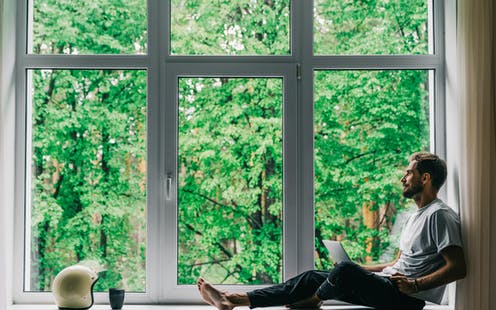Zamuruew/Shutterstock
In the year since the city of Wuhan, China, went into the world’s first coronavirus lockdown, we have all had to live under some form of pandemic-related restriction.
Some countries have opted for strict national lockdowns, like the one currently in place in the UK, while other countries such as Taiwan have opted for border closures and mandatory quarantine for overseas arrivals. Such different approaches to restricting movement have different effects on our well-being.
It is now well documented that the pandemic has generally contributed to a number of mental health problems including stress, anxiety and depression. But what role do restrictions on movement play in this? And how do they differ?
Different pandemic restrictions
Researchers around the world are now focusing on what the specific impact of lockdown, quarantine and isolation might have upon our mental health. Lockdown, in the context of COVID-19, refers to implementation of strict community restrictions on travel and social interaction as well as denying access to public spaces.
Quarantine is a restriction of movement of those people who have been exposed to a contagious disease to observe whether they will become ill. In Australia, for example, all overseas arrivals must spend 14 days in hotel quarantine before being allowed into the community.
Self-isolation, meanwhile, is the separation of those who have become sick as a result of a contagious disease in order to separate them from others who are not sick.
Quarantine
Looking to past pandemics can help us understand this one. A recent academic review examined studies of people who had been quarantined as a result of other disease outbreaks such as Ebola, SARS and swine flu. The review concluded that quarantine can lead to a number of harmful psychological effects.
One outcome is the fear and anxiety that can increase due to worries about catching or transmitting the virus, and concerns about the health, social and economic effects of the pandemic. Individuals can also experience anger at the changing policies and protocols that impinge upon their everyday life and feelings of control.
And the long-term effects of quarantine can lead to some people subsequently developing a post-traumatic stress reaction, which can manifest in feelings of exhaustion, low mood and irritability.
Lockdown vs self-isolation
For lockdown and self-isolation measures, we have data from the COVID-19 pandemic itself.
Research from Italy, which was hit hard early in the pandemic and had an extensive lockdown, has found that more than one-third of the general public experienced significant psychological distress during the second month of coronavirus restrictions.
In a forthcoming study, my colleagues and I looked at what impact lockdown and had on psychological well-being and happiness compared to self-isolation. From March to July 2020, we assessed a sample of UK adults who were under one of three types of restrictions: self-isolation, full lockdown or partial lockdown (full lockdown is remaining at home and not going to work, whereas partial lockdown allows you to go to work).
After controlling for variations in age and sex, we found that those in self-isolation reported significantly lower levels of psychological well-being and happiness when compared to those in lockdown or those in partial lockdown, with no difference between the last two groups.
These findings suggest that self-isolation impairs psychological well-being and happiness to a greater degree than lockdown.
Caging the social animal
COVID-19 restrictions heighten the fears people have about health and safety as well as financial and social consequences. Self-isolation may add to this due to a prolonged separation from friends and family – those who provide a close support network. This is because during self-isolation you should avoid contact with everyone, even those in your household.
The finding of no difference between those in full lockdown and partial lockdown is equally interesting. This suggests that people can maintain a sense of satisfaction, optimism, engagement and a positive mood state despite the restrictions placed upon them, testifying to the resilience of humans under difficult conditions.
Humans are essentially social animals. Our large brains have developed to embrace social contact and develop skills that have helped us survive and prosper. These skills include language, problem-solving and planning, as well as empathy and care for others. We are hard-wired for social contact and communication.
Social isolation breaks many of these forms of communication and interactions, which are key to forming strong social bonds. It should therefore come as no surprise to find that prolonged periods of isolation can lead to a range of psychological problems, just as it does in the abnormal behaviour and communication found in a caged animal.
One year on, we are still yet to understand the full psychological fallout of COVID-19. But working out how different restrictions affect us our inner social animal is an important place to start as we navigate our way out of this pandemic and prepare for the next one.
![]()
Tom Heffernan does not work for, consult, own shares in or receive funding from any company or organisation that would benefit from this article, and has disclosed no relevant affiliations beyond their academic appointment.











